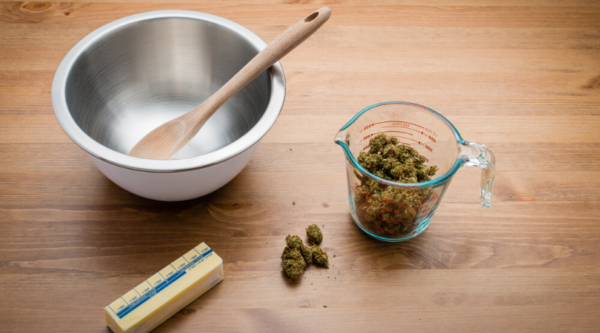Cooking with cannabis is a project that every marijuana fan should try at least once. It’s easy enough for anyone to handle right at home and you can enhance all of your favorite meals, snacks, and even drinks by making a potent cannabis-infused condiment such as cannabutter. However, people often make mistakes cooking with cannabis and making cannabutter.
Although anyone can learn to cook with cannabis, it’s not as simple as just mixing some weed into your food and calling it a day. There are a few important steps that you need to carry out and users make mistakes while cooking cannabutter all the time. Fortunately, these mistakes are easy to avoid if you know what you’re doing.
There are also a few mishaps you’ll want to avoid after you’ve finished cooking- edibles are extremely potent and they need to be used with caution. However, you shouldn’t be put off. Marijuana-infused foods can offer an extremely enjoyable experience as long as you use them safely and responsibly. Here’s a guide on some of the top mistakes made while cooking with cannabis and how to avoid them.
1. Not Decarboxylating Your Cannabis First
The best way to cook with cannabis is by infusing your cannabis into a condiment. The cannabinoids in cannabis bind with fats, so it can be infused into oil, lard, or even milk, but the best way to use it is to make cannabutter. However, before you even start making cannabutter, you’ll need to decarboxylate your cannabis.
Failing to decarboxylate weed before infusing it into your food is the biggest mistake that users make when cooking with cannabis. Decarboxylation involves heating your marijuana before cooking with it to activate the THC and other cannabinoids inside. If you don’t carry out this step, your edibles won’t make you high and the whole process of making them will be pointless.
Decarboxylating your weed is simple. Start by preheating your oven to 245°F and spreading out some buds of cannabis on a baking tray covered with parchment paper. You can then place it in the oven for around 2-3 hours while shaking the tray occasionally to ensure your buds are decarboxylated evenly.
It’s important not to increase the temperature while your cannabis is decarboxylating. You need to activate the THC in your weed without burning it, and if you accidentally use a temperature that’s too high you’ll end up with toasty yet ineffective buds. Once you’ve finished decarbing your weed, place the tray on the side and allow it to cool before grinding it and cooking with it.

2. Grinding Your Cannabis More Than You Need To
Another common mistake that people make when they cook with cannabis is grinding their weed too finely. It’s best to use small pieces of weed when you’re making cannabutter, but you’ll still want your ground cannabis to be chunky enough that you won’t end up with a bunch of cannabis in your butter.
When you make cannabis butter, you leave your weed to simmer in butter until the THC has bound to the fats in your butter. After that, you strain the mixture into a container to separate the butter from any excess weed. The problem is that, if you’ve ground your weed too enthusiastically, you could end up with chunks of weed in your cannabutter.
Fortunately, there are ways to avoid ending up with clumps of weed in your cannabutter. It’s best to use a cheesecloth for straining as opposed to a regular strainer- this makes it much harder for any cannabis to make it through. However, it’s still best not to grind your weed too much.
If you’re cooking cannabis butter, just grind your weed like you usually would but don’t try and make it too fine. Don’t put your cannabis in a blender, either- this will reduce its potency. It’s also best to grind your weed after you’ve decarboxylated it- trying to decarboxylate fine cuts of weed can result in them burning too easily.
3. Adding Too Much Cannabis To Your Cannabutter
When it comes to making your cannabis butter, it’s important to be mindful of how much you use. Naturally, you’ll want to avoid using so little cannabis that your cannabutter ends up not getting you high. However, rookies usually have more of a tendency to add too much cannabis to their cannabutter.
Although you want your cannabutter to be nice and potent, using too much weed is a mistake. When you consume cannabis-infused edibles, it hits you much harder than smoking or vaping weed does. What’s more, the effects last for much longer. As such, you don’t need to use that much weed in your butter.
You’ll also want to use enough butter to spread the THC out thoroughly. You don’t want cannabutter that’s going to make you overwhelmingly high with just a tiny amount, so make sure you have a good ratio of cannabis to butter while not using too much.
A good rule of thumb for beginners is to use 1 cup of butter and 1 cup of water for every 7-10 grams of weed they plan to use. This will give you a good batch that isn’t too strong or weak. If you’ve never tried edibles before and want to get used to the effects, it’s best to start with less or even try using just 3.5 grams of weed with half a cup of butter and water.

4. Boiling Your Cannabutter
Once you’ve decarboxylated your weed, making cannabis butter is fairly straightforward. You just have to melt a cup of butter with a cup of water in a saucepan and add your ground, decarboxylated weed. After that, you just have to let the mixture simmer for 2-3 hours while stirring it occasionally.
However, a mistake that many users make is letting their cannabis butter boil. Throughout the whole process, your mixture should simmer without boiling. When the temperature becomes too high, it can degrade the potency of your cannabis butter, so you’ll want to avoid this.
While you’ll need a medium temperature to melt your butter, it’s best to reduce the heat to a low temperature and let it cool for a few minutes before you add your cannabis. A temperature of around 160-180ºF is ideal for simmering your cannabis butter.
If you notice that your cannabis butter is starting to boil, then remove it from the heat instantly. Your cannabis butter won’t instantly be ruined, but you’ll want to let it cool until it stops boiling and then put it back on the stove at a lower heat.
5. Trying To Fry With Cannabutter
Even after you’ve finished cooking your cannabis butter, it’s still sensitive to high heat. Baking with cannabis butter works especially well since you can bake at a moderate temperature without degrading the THC in your cannabis butter. However, you’ll want to avoid certain methods of cooking.
THC completely degrades at around 390°F, and even temperatures close to this can cause it to start breaking down. Baking allows you to use temperatures well below this point, so your THC won’t be degraded. However, make sure you don’t try and fry with your cannabis butter.
While it might be tempting to use cannabutter as a replacement for regular butter when you’re cooking something in the pan, the THC will simply degrade if the temperature becomes too high. You’ll also want to avoid microwaving it as this can often lead to degradation as well.
If you want to add your cannabis butter to hot meals, the best approach is to add it after you’ve finished cooking. If you want your cannabutter to be warm, melt it along with some water in a saucepan at a low temperature. Water helps keep it cool whereas low temperatures will ensure your cannabis butter doesn’t lose its potency.

6. Not Paying Attention To Dosages
While many mistakes can happen during the process of cooking cannabis, one of the most dangerous mistakes is eating too much of the edibles you make. Eating edibles doesn’t hit you like smoking or vaping weed does- the effects are significantly stronger and longer-lasting. As such, you need to make sure you don’t eat too much.
The best way to do this is to split your edibles into sensible serving sizes. Ideally, you’ll want to figure out how much THC is in your edibles. For example, a gram of weed is 1000mg, so if you use half a gram of weed to make cannabutter (500mg) and your weed is 20% THC, your butter will contain 100mg of THC.
After figuring out how much THC is in your cannabis butter, you can figure out how much is in your edibles. For instance, if your cannabis butter contains 100mg of THC and you use exactly a tenth to make a cannabis brownie, your brownie will contain 10mg of THC. This is a good dose for beginners.
It can be tricky to work out the exact amount of THC in your homemade edibles- especially if you don’t know how much THC is in your weed. The best approach in these cases is to try a small serving of your homemade edible products to see how strong they are. It’s also important to remember that the effects of edibles can take 30-90 minutes to kick in, so be patient.
7. Not Seasoning Your Cannabis Edibles
Cannabis butter goes well with all kinds of meals, snacks, and baked goods. However, the edibles that you make might still leave a strong aftertaste of weed when you eat them. This isn’t a problem for some users and you might even enjoy it, but those who want to avoid it should make sure they season their edibles to perfection.
Since cannabis butter still carries the strong taste of weed, using some extra seasoning when you cook with cannabis can go a long way. If you’re adding some cannabis butter to your meal, try adding some herbs and spices along with it to mask the taste of cannabis and make your meal more enjoyable overall.
When you’re making treats like cannabis brownies or cookies, some extra flavorings and toppings can go a long way. For instance, adding a dash of cinnamon and brown sugar can help your baked goods taste much better, as can adding some chocolate chips or chocolate icing.
You can use whatever seasonings and flavorings you want to make your edibles taste nicer, and some users may prefer not to use them. While it’s not the biggest mistake you can make, it’s still something worth considering.

8. Not Experimenting With Your Edibles
When most people make cannabis butter, they tend to use it for the most popular types of edibles such as marijuana cookies, brownies, and cakes. However, don’t forget that you can get extremely creative with your edibles.
There are all kinds of delicious ways to incorporate cannabis into your food, so don’t make the mistake of sticking purely to baked goods. For instance, you could add a dash of cannabis butter to a plate of spaghetti carbonara or fettuccine alfredo. You can also use it to enhance your favorite sandwiches and salads.
You don’t just have to add it to foods, either. You can also enhance your drinks with the effects of cannabis. Your cannabis butter can be melted and added to tea, coffee, smoothies, or juices if you want to add an extra kick of THC. That way, you’ll have a refreshing marijuana-infused beverage.
There’s plenty of space for creativity when it comes to cooking with cannabis so make sure you try it in various ways- just avoid the other common mistakes such as exposing it to high heat or using too much. If you need some inspiration, check out some of our best edible marijuana recipes.
Conclusion
If you enjoy the effects of marijuana, cooking with marijuana is worth trying. Not only will you end up with some delicious marijuana-infused edible creations, but they’ll also give you a sensational high. Just make sure you avoid these common mistakes and you’ll end up with some tasty and potent THC-infused foods and drinks.
Of course, you can also skip the cooking altogether and buy marijuana edibles online. This is a great option if you want to know exactly how much THC each serving contains and avoid overpowering effects. You can also find plenty of marijuana strains, concentrates, tinctures, and more at Runtz Shop.




Having read this I thought it was rather enlightening.
I appreciate you finding the time and effort to put this content together.
I once again find myself personally spending a significant amount of time both reading and posting comments.
But so what, it was still worthwhile!
Here is my web site – Christin